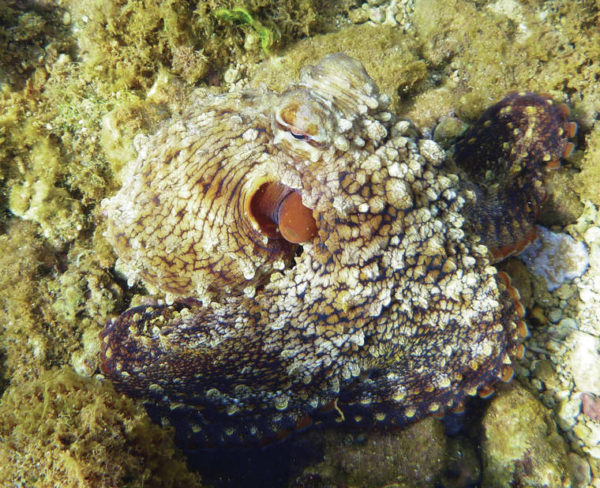Published in the Ocean Watch column, Honolulu Star-Advertiser © Susan Scott
July 13, 2019
During an early morning snorkel, I rounded a coral head and to my surprise found myself face to face with an octopus. The creature, propped on its arms like a living sculpture, matched its background so perfectly, I easily could have missed it. But before the octopus froze, I caught a glimpse of movement and, fortunately, had my camera in hand.
A second after I snapped its picture, though, the creature decided it wasn’t safe sitting out there in the open. The little octopus shot out a cloud of black ink, which had the intended effect of startling me and clouding the water. When it cleared and I had my wits about me again, the octopus was long gone.
 An octopus, a moment before it spewed ink and disappeared.
An octopus, a moment before it spewed ink and disappeared.
©2019 Susan Scott
An octopus looks like bagpipes with suction cups on eight arms, a breathing tube and two bulging, eerily attentive eyes. Octopuses look so weird that science fiction movie makers often feature versions of the creatures as monsters, and in real life most people view octopuses only as food.
But these marine animals are not aggressive to people and are so resourceful and intelligent that they deserve our respect.
For an animal without a backbone, an octopus has an unusually large cluster of nerve cells, called neurons, centralized in its head. In this brain, researchers have found areas dedicated to learning and memory storage. This explains how octopuses can navigate their way through mazes, solve problems and remember the answers.
But only about a third of an octopus’ neurons are in its head. The other two-thirds are spread out in the arms, with nerves running to each sucker. Sucker numbers vary greatly with species, but totals are usually in the hundreds. Such an extensive nerve network enables the creature to independently fold the sides of each sucker together in a grasp.
And we humans thought we were special with our grasp of one thumb and one forefinger on only two appendages.
Being boneless, an octopus can squeeze through an opening no bigger than its eye. Octopuses in aquariums are escape artists, using their sucker dexterity to take apart tank gear, walk to neighbor tanks to forage and then return home. In the wild, one captured octopus opened the zipper in its holding bag and pulled the face mask off the diver who caught it.
In Hawaii octopuses are called hee (Hawaiian), tako (Japanese) or squid (local vernacular). Several species inhabit Hawaii reefs, hunting for crabs and shrimp day or night, depending on species. Our largest octopuses grow 2 to 3 feet long from the head to the end of the outstretched arms.
The late Jacques Cousteau wrote of the octopus, “It is somehow ethereal and at the same time elaborate, elegant and slightly mischievous.”
I agree and consider it an honor have crossed paths with an octopus. Even if the rascal did throw ink in my face.